There is not one but eczemas. On the occasion of the national day of awareness of this skin disease, Why Doctor exposes you to its different variants.

- Eczema affects the quality of life of 2.5 million French people of all ages.
- Eczema is a chronic skin disease that occurs through inflammatory flare-ups and can affect all parts of the body.
atopic eczema
Atopic eczema (or atopic dermatitis) is a chronic skin disease caused by a genetic abnormality of the skin barrier. The latter is responsible for the excessive dryness and permeability of the skin to all external aggressions (pollen, dust, mites, etc.). It corresponds, in particular, to the fact of having and producing too many specific antibodies, called immunoglobulins E (IgE).
Atopic eczema is manifested by dry, porous skin, isolated prurigo papules and, during inflammatory outbreaks, by red patches (dry or oozing with vesicles, crusts), or edema, accompanied by severe itching. This itching can generate lesions that are sometimes complicated by infections and metabolic disorders.
Chronic hand eczema
Chronic hand eczema (CME) is a pathology that can remain isolated or appear in a context of more generalized eczema.
Evolving through flare-ups (where the skin is red and itchy) and lulls (where the skin appears dry), ECM mainly concerns adults (particularly women) because it is often caused and/or aggravated by household or professional products, but also cold and excess heat. “It is a particularly disabling pathology on a daily basis, which impacts social, professional, friendly or romantic relationships”, specifies the French association of eczema. It is often accompanied by itching, pain, but also insomnia, depression, social phobia, disability and/or sick leave.
allergic eczema
Allergic contact eczema is linked to direct contact of the skin with certain materials or substances that trigger an allergic reaction, often localized around the contact area, which leads to a local or generalized outbreak of eczema.
Many everyday objects are potential allergens: fancy jewellery, belts, mobile phones, keys, coins, clothes, shoes, cosmetics, deodorants, soaps, shampoos, dyes, paints, glues, metals… most often composed of nickel, chromium, formaldehyde, cobalt and other substances harmful to the skin.

.















